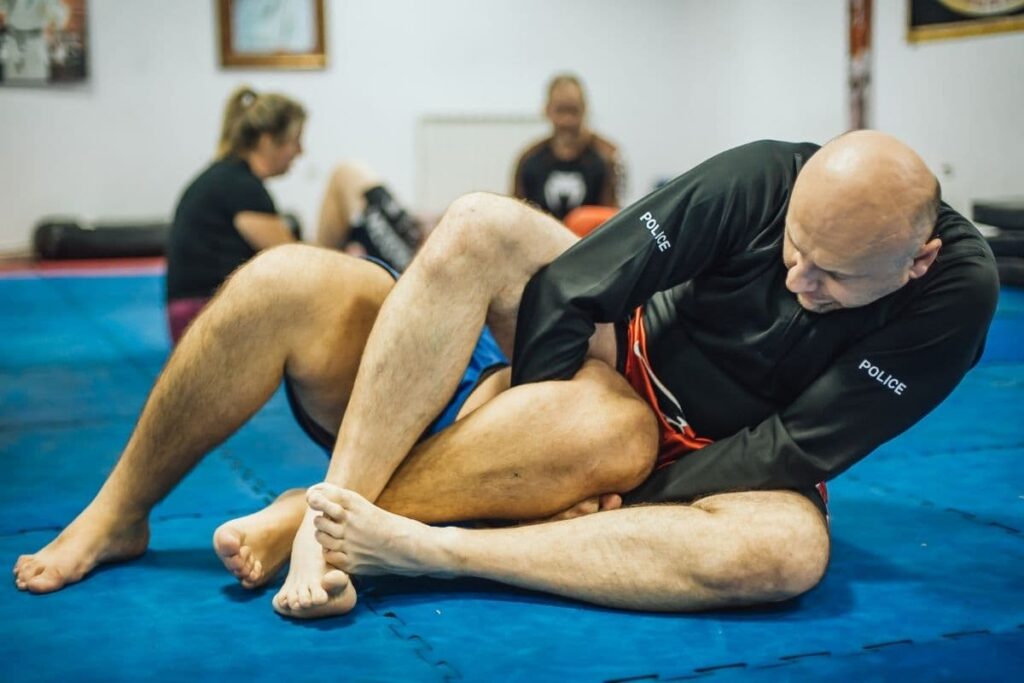If you know or practice Brazilian Jiu-Jitsu, it’s important to know that leg locks are here for the long haul. In the past, leg locks were looked down on in the mainstream Brazilian Jiu-Jitsu competition. Nowadays, if you want to have any chances of winning mid-level to high-level no gi Brazilian Jiu-Jitsu, you must know leg locks!
In Brazilian Jiu-Jitsu, leg locks attack the joints that are located below the waist. These include hips, knee, and ankle joints of the body of the opponent.
Leg locks stray from classic positions in Brazilian Jiu-Jitsu such as the back, mount, and side control, due to the position of the body that are needed to apply leg locks. For this reason, a leg locker can’t be assessed in a proper manner by the traditional scoring system in the International Brazilian Jiu-Jitsu Federation, or the IBJJF.
As a matter of fact, many leg lockers don’t even try to go through traditional control series and pass guards. The reason being that most leg locks can’t be applied from traditional control positions in Brazilian Jiu-Jitsu!
History of Leg Locks
Ancient hand-to-hand combat forms, such as the Greek pankration, entail the history of leg locks. With roots in Judo and Japanese Jiu-Jitsu, leg locks were always a part of the Brazilian Jiu-Jitsu submission system.
In the past, leg locks were frowned upon in the Brazilian Jiu-Jitsu community and were seen as a cheap move. Another thing that contributed to the declining popularity of the leg lock in the earlier years of Brazilian Jiu-Jitsu was the fact that some entry and leg submission positions were restricted by the IBJJF.
However, the popularity of the leg lock has been on the rise in the past few years. The main reason for this is that there are more competitive events that have fewer restrictions when it comes to leg locks. The sudden burst of popularity that leg locks have experienced can also be attributed to athletes such as Gordon Ryan,Craig Jones, and Dean Lister.
The leg lock game can now be learned by practitioners more easily thanks to the specific systems of learning that have been developed in the past few years. Leg locks are seen as an important part of the Brazilian Jiu-Jitsu game now more than ever.

How to Safely Train Leg Locks
In order to safely train leg locks, you first need to choose the right partner. You need to take extra care of yourself due to the risky nature of the leg lock game, and it’s ideal to partner up with someone who is experienced.
If your partner is experienced, they’ll be able to teach and guide you through the rounds in a safe manner. If having an experienced partner isn’t an option, you should look for a partner that you’re familiar with.
Another thing you need to watch out for is to avoid full intensity rolls right at the start. Disaster will inevitably occur if you’re doing intensity rolls from the start and you’re not experienced enough in leg locks. You’ll get to know your own limits once you rep the submissions and finish slowly until either your partner or yourself tap. By doing this, you’ll get a feel of the movements in your joints and the range that you have.
Lastly, the pressure you apply should be done in a slow manner. During leg submission, your partner and you should learn how to apply pressure slowly. Especially when it comes to heel hooks, you should learn to apply just the right amount of pressure in order to hold the position in place. If the submission cannot be held in place without applying too much pressure, the problem might not be your intensity, but how the technique is applied.
Anytime your partner and you are in a knee reap position, make sure that you know that a big amount of force is applied to your knee’s sides. To relieve this pressure, you need to react and turn accordingly.
How to Learn Leg Locks
Below, we’re going to go over some tips on how to effectively learn leg locks!
Keep Your Skill Level in Mind
You must start learning the mechanics of the straight ankle lock and the standard ashi garami if you’re a beginner that’s looking to learn the leg lock game. Learning how to counter, defend, reverse, and apply the position and submission will help you understand the leg lock game basics.
You can progress by adding the toeholds and the butterfly ashi once you’ve learned this. If you want to try out the 50/50 position, it will be helpful if you learn options for sweeps, counters, back takes, and the basics of the position before you start adding leg locks!
Positional Sparring
Instead of focusing on full-on drills or rolls, you should focus on position sparring if you want to learn specific techniques or positions. An example of a positional sparring session would be setting the time for two or more minutes, getting into position with your partner, and start attacking as they try to escape or defend themselves.
If a reversal, escape, submission, or change in position happens, you go back in the same saddle position and repeat the process until the time runs out. It’s now your partner’s turn once the two minutes go by. You can also set the timer for longer, such as ten or twenty minutes, and you can switch attacking positions every time an event happens.
Find New Ways to Learn
Nothing is better than having a qualified professor or instructor while you’re trying to get more knowledge on these positions. However, if this isn’t possible, there’s still a lot of information you can get online for free.
You’ll be able to gain more insights on the concepts of these techniques by watching matches and breaking them down. When a partner isn’t available for training, you can get a lot of help through visualization training!
Work Backwards
Work backwards to entries from positions. Once you’ve become acquainted with the actual position, the entries should become a lot easier. You can start positional sparring for entries from specific positions, such as the butterfly guard or SLX, once you’re a bit more familiar with the saddle position. Learn to transition from one position to another one once you know most of the positions!
Don’t Neglect Brazilian Jiu-Jitsu Basics
Before or while you’re learning the leg lock game, it’s important that you learn the basics of Brazilian Jiu-Jitsu. Practitioners that excel in leg submissions are able to do that because they have a great understanding of the basics of Brazilian Jiu-Jitsu.
Learn the Reversals, Counters, and Escapes
Learn the reversals, counters, and escapes for all submissions and positions, since all positions have a weakness. Brazilian Jiu-Jitsu is too complex and fast to be able to react to everything that’s happening.
If you learn all of the possible scenarios that can occur, you can stay a few steps ahead of your opponent. The best way to do this is to get to know the defensive and the offensive ends of a position. You can mitigate the weakness of a submission or position by anticipating what your opponent will do.
Final Thoughts
Leg locks are more popular than ever now! From your gym mats to the competition circuit, practitioners are showing more and more interest in this technique. It’s becoming very common to see matches that end with a leg lock submission in many of the top grappling competitions.
Before you go to your training partners and friends with a leg lock, we hope that you’ve carefully read through our guide and know all the steps you need to take in order to properly execute a leg lock!
Now that you have a good idea of the most common and important leg submission, it’s time to find a training partner that shares the same wish as you do to learn these techniques. When everyone is aware of the technique and knows what to do, practicing leg locks with your partner can be a pretty fun thing you do.
We hope that this guide has given you more knowledge of Brazilian Jiu-Jitsu and leg locks. For more information, please feel free to keep exploring our site!

